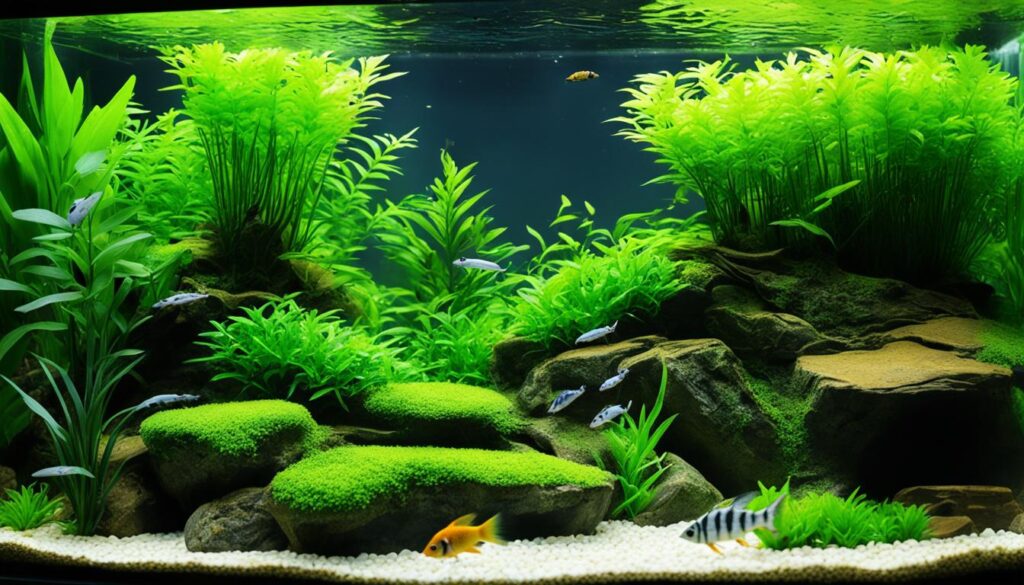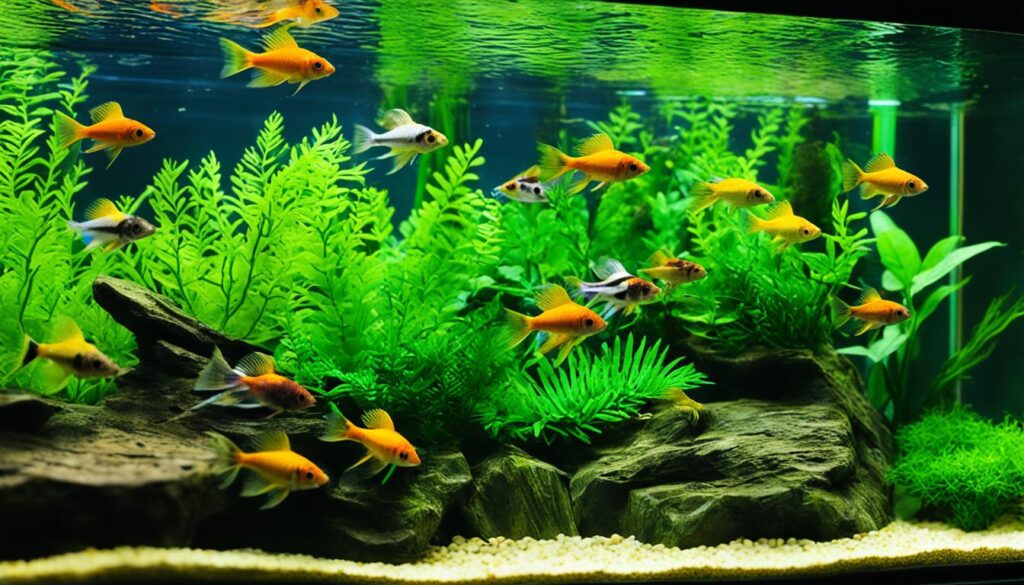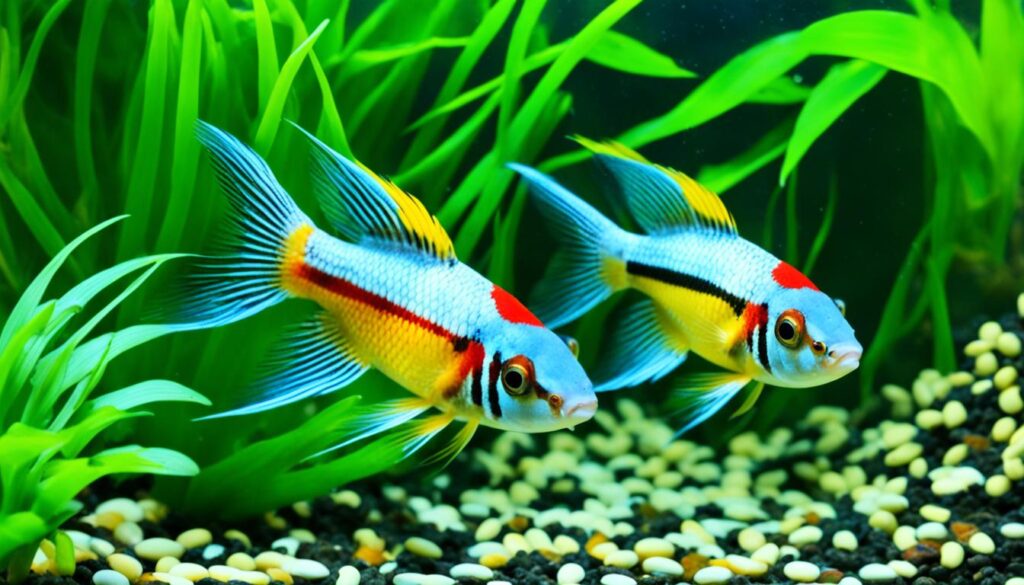Are you looking to add a splash of vibrant color to your freshwater aquarium? Look no further than the Apistogramma cichlids. These small and curious fish come in a variety of stunning colors and have a unique interactive behavior. But, how do you take care of these little beauties and ensure they thrive and reproduce successfully?
In this comprehensive Apistogramma care guide, we will explore everything you need to know about these fascinating fish. From their behavior and tank setup to their diet and breeding habits, we’ll cover it all. Get ready to dive deep into the world of Apistogramma cichlids and become an expert in their care and maintenance.
Key Takeaways:
- Apistogramma cichlids are small and vibrant fish that make a great addition to any community tank.
- They require specific tank setups with warm water, hiding spots, and live plants.
- Apistogrammas are micropredators and thrive on a well-rounded diet.
- Breeding apistogrammas requires proper setup and attention to their needs.
- With the right care, these fish can bring endless enjoyment to their owners.
What are Apistogramma Cichlids?
Apistogramma cichlids are a fascinating genus of fish native to South America. With nearly 100 different species, each displaying unique color variations, these cichlids are renowned for their vibrant and eye-catching appearance.
Male apistogrammas are particularly striking, boasting vivid colors and elongated dorsal fins that add to their allure. In contrast, females possess more subdued and camouflaged colors, providing optimal protection for their nests during breeding.
One of the most captivating aspects of apistogramma cichlids is their interactive and inquisitive behavior. These curious fish often venture near the walls of their tanks, providing an enjoyable experience for aquarists as they engage with their aquatic companions.
Whether you’re a beginner or a seasoned hobbyist, apistogramma cichlids are sure to captivate you with their stunning colors and endearing personalities. Let’s dive deeper into the world of these amazing fish and explore the various species and characteristics.
Types of Apistogramma Cichlids
Apistogramma cichlids are known for their diverse colors and unique characteristics. Let’s explore some popular types of apistogramma cichlids:
Apistogramma Cacatuoides (Cockatoo Dwarf Cichlid)
Apistogramma cacatuoides, also known as the cockatoo dwarf cichlid, is a stunning species with various color variants available. Some popular color variations include Super Red and Orange Flash. These cichlids feature vibrant hues that make them a focal point in any aquarium.
Apistogramma Agassizii (Three-Striped Dwarf Cichlid)
Apistogramma agassizii, often referred to as the three-striped dwarf cichlid, is another popular species among aquarists. This cichlid species showcases beautiful color variations such as Fire Red and Gold. With their striking appearance, they add visual interest to any tank.
Apistogramma Borelli (Umbrella Dwarf Cichlid)
Apistogramma borelli, commonly known as the umbrella dwarf cichlid, displays a light blue body color with lemon-yellow fins. This species is known for its peaceful temperament and a pleasant addition to community aquariums.
Apistogramma Trifasciata (Three-Striped Dwarf Cichlid)
Apistogramma trifasciata, or the three-striped dwarf cichlid, exhibits three black horizontal lines on its body and vibrant blue fins. This species offers an eye-catching display and thrives in well-maintained aquarium setups.
These are just a few examples of the captivating apistogramma cichlids available in the aquarium hobby. Each species possesses unique traits and visual characteristics, making them a delightful addition to freshwater tanks.
Setting Up an Apistogramma Aquarium
When it comes to setting up an aquarium for your Apistogramma cichlids, there are a few key factors to keep in mind to ensure their health and well-being.
Firstly, it’s important to provide your Apistogrammas with the right tank size. These fish do best in a 20-gallon or larger aquarium, especially if you plan on keeping them in a community setup. A larger tank will give them more space to swim and explore.
Next, you’ll want to maintain the optimal water conditions for Apistogrammas. They thrive in warm water with a temperature range of 80-82°F. The pH level should be slightly acidic to neutral, and the water hardness should be moderate. Regular water testing and appropriate adjustments are necessary to ensure the ideal conditions.
To create a suitable environment for your Apistogrammas, it’s crucial to provide plenty of hiding spots. These fish are territorial and seek shelter in caves, so incorporating caves and hardscape into the tank is essential. Catappa leaves, also known as Indian Almond leaves, can be added to the aquarium to create natural hiding places and release beneficial tannins into the water.

Another important aspect of the tank setup is the presence of live aquarium plants. Dense foliage helps reduce aggression among the fish and creates visual barriers, breaking the line of sight. Some suitable plant options include Java fern, Amazon sword, and Vallisneria.
In terms of substrate, fine sand is recommended for Apistogramma tanks. These fish like to sift through the substrate, and fine sand allows them to do so without damaging their delicate fins. Avoid using sharp or coarse gravel, as it can harm the fish.
Here’s a table summarizing the key elements of an Apistogramma tank setup:
| Tank Size | Water Temperature | pH Level | Water Hardness | Hiding Spots | Live Aquarium Plants | Substrate |
|---|---|---|---|---|---|---|
| 20-gallon or larger | 80-82°F | Slightly acidic to neutral | Moderate | Caves, catappa leaves, hardscape | Dense foliage | Fine sand |
By following these guidelines and providing a suitable tank setup, you can create a thriving environment for your Apistogramma cichlids to enjoy.
Apistogramma Tank Mates and Compatibility
While apistogrammas are labeled as semi-aggressive fish, they generally do well in most community aquariums. They prefer tank mates that occupy the middle to top half of the tank, leaving the bottom half for the apistogrammas. Tetras, pencilfish, hatchetfish, and other similar species are ideal tank mates.
Table: Compatible Tank Mates for Apistogrammas
| Tank Mate | Compatibility |
|---|---|
| Tetras | Good Compatibility |
| Pencilfish | Good Compatibility |
| Hatchetfish | Good Compatibility |
However, they may prey on dwarf shrimp, baby fish, and other small creatures. It is also important to avoid pairing apistogrammas with betta fish, as both species are territorial and semi-aggressive.
Note: Always monitor the tank dynamics when introducing new tank mates. If any aggression or stress is observed, it is advisable to remove the incompatible species to maintain the well-being of your apistogrammas.

Creating a Balanced Community Tank
In order to create a harmonious community tank for your apistogrammas, it is important to consider their specific needs and behaviors. Here are some tips to create a balanced environment:
- Provide plenty of hiding spots and visual barriers using plants, rock formations, or driftwood. This will help to reduce aggression and establish territories within the tank.
- Maintain a suitable water temperature, pH, and hardness that align with the requirements of both the apistogrammas and their tank mates.
- Ensure the tank is adequately sized to accommodate the number of fish and their space requirements. Overcrowding can lead to territorial disputes and stress.
- Keep a close eye on the behavior and health of all tank inhabitants, addressing any signs of aggression or distress promptly.
By carefully selecting compatible tank mates and creating a conducive environment, you can enjoy the vibrant colors and interactive nature of your apistogrammas while maintaining a well-balanced community tank.
Apistogramma Diet
Apistogrammas are micropredators and thrive on a well-rounded diet. To keep your apistogrammas healthy and vibrant, it is important to provide them with a variety of foods that mimic their natural diet. Here are some key components to include in an apistogramma’s diet:
Protein-Based Foods
Apistogrammas can be fed a protein-based diet consisting of:
- Bloodworms
- Tubifex worms
- Blackworms
- Smaller pellets
Roughage and Plant Matter
To prevent bloating, it is important to mix in some roughage and plant matter. This can include:
- Vegetables like blanched spinach or zucchini
- Algae wafers
- Krill or brine shrimp
Sinking Fish Foods
Apistogrammas can also be fed sinking fish foods such as:
- Repashy gel food
- Pellets specifically formulated for cichlids
“A varied diet ensures that your apistogrammas receive all the necessary nutrients for their optimal health and growth.” – Aquarium Co-Op
Remember to feed your apistogrammas in small quantities multiple times a day to match their natural grazing behavior. Additionally, consider supplementing their diet with live or frozen foods like daphnia and mosquito larvae to provide additional enrichment and stimulate their hunting instincts.
Breeding Apistogramma Cichlids
Apistogrammas are popular among aquarists for their breeding behavior. These small and vibrant fish are cave spawners and exhibit remarkable parental care towards their young. Breeding apistogrammas can be a rewarding experience, but it requires some essential considerations.
Identifying Male and Female Apistogrammas
Before breeding apistogrammas, it is crucial to ensure that you have both a male and a female. However, identifying their gender can sometimes be challenging, as there are no distinct visual differences between males and females.
One way to determine the sex of your apistogrammas is by observing their behavior. During the breeding season, males become more territorial and exhibit vibrant colors to attract females. The males may also display courtship behaviors such as flaring their fins and performing intricate dances.
Setting Up a Breeding Aquarium
To create an ideal breeding environment for apistogrammas, it is recommended to set up a separate 10-gallon aquarium. This smaller tank provides a more controlled space for the breeding process.
When setting up the breeding aquarium, include ample hiding spots in the form of caves, plants, and driftwood. These hiding spots mimic the natural habitat of apistogrammas and provide them with a sense of security during the breeding process. Additionally, a sponge filter should be used to enhance water quality without creating a strong current that could disturb the eggs or fry.
Adding catappa leaves to the aquarium can also benefit the breeding process. These leaves release tannins into the water, creating a natural environment that helps stimulate breeding behavior in apistogrammas. Live plants like Java moss or Amazon sword plants can further enhance the breeding setup by providing additional cover and creating a natural ecosystem.
Parental Care and Fry Growth
After spawning, the female apistogramma will guard the eggs while the male defends the territory. The eggs typically take a few days to hatch, and during this time, the female will continue to protect them.
Once the fry hatch, they will initially feed on the egg sac for nourishment. As they grow, it is important to provide them with tiny foods that are suitable for their small size. Infusoria and baby brine shrimp are excellent options for feeding the fry and ensuring their healthy development.
It’s worth noting that apistogramma fry are relatively delicate, and consistent water quality and appropriate feeding are crucial for their survival.
To summarize, breeding apistogrammas requires careful observation, proper setup, and attention to detail. With the right conditions and care, you can witness the fascinating breeding behavior of these beautiful fish and enjoy the satisfaction of successfully raising their offspring.
Conclusion
Apistogramma cichlids are a fascinating addition to any freshwater aquarium. Their vibrant colors and curious nature make them a delight to observe. However, to ensure the health and well-being of these beautiful fish, it is crucial to provide them with the right tank setup and care.
Setting up an apistogramma tank requires attention to detail. The water parameters should be carefully monitored, with a temperature of 80-82°F and a slightly acidic to neutral pH. Creating hiding spots with caves, catappa leaves, and hardscape will give apistogrammas the security they need in their territory. Live aquarium plants not only add beauty to the tank but also provide shelter and help minimize aggression.
When it comes to tank mates, choose species that occupy different areas of the tank, allowing apistogrammas to claim the bottom half. Tetras, pencilfish, and hatchetfish are excellent choices. However, be cautious with dwarf shrimp and baby fish, as apistogrammas may consider them as prey. Avoid pairing apistogrammas with betta fish to prevent territorial conflicts.
Feeding apistogrammas a well-rounded diet is vital for their overall health. They are micropredators and thrive on a protein-based diet, including bloodworms, tubifex worms, and smaller pellets. Adding some roughage, such as plant matter and crustaceans, helps prevent digestive issues and bloating. Don’t forget to offer them a variety of sinking foods, like Repashy gel food, to ensure their nutritional needs are met.
If you’re interested in breeding apistogramma cichlids, it can be a rewarding and exciting experience. However, it requires a dedicated setup and attention to their specific needs. Offering a 10-gallon breeding aquarium with ample hiding spots and a sponge filter is essential. Females will guard the eggs while males defend the territory. Providing tiny foods like infusoria and baby brine shrimp will support the fry’s growth.
With proper care and attention, apistogramma cichlids can thrive in your aquarium and provide endless enjoyment. Their vibrant colors and interactive behavior will captivate any fish hobbyist. Follow the guidelines provided in this care guide and embark on a journey filled with wonder and beauty as you care for these remarkable cichlids. Remember, the key to a healthy and thriving apistogramma community lies in your dedication and love for these incredible fish.

